Fossil Specimens of Marine Creatures (3/5)
Lady Fish (Elopidae) (with its pair)
| The fossil pictured has both positive and negative slabs. |
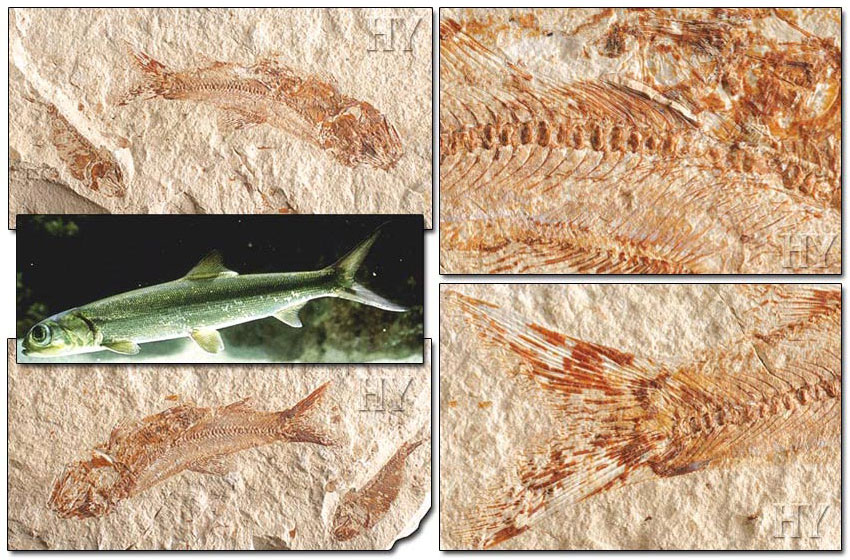 |
Age: 95 million years
Period: Cretaceous
Location: Haqel, Lebanon
Michael Ruse sums up evolutionists' difficulties in the face of the fossil record in these terms:
"He [Darwin] had to show not only why he thought there would be few if any transitional forms but also why the fossil record starts so suddenly. The record does not go very gradually from the most primitive up to the most complex but starts off with a bang with really quite complex and sophisticated forms." (Michael Ruse, The Evolution Wars: A Guide to the Debates, Rutgers University Press, 2001, p. 49)
Darwinists insist on refusing to see this groundlessness. The theory of evolution has been defeated by fossil findings, which have in turn demolished evolution. The 95-million-year-old fossil Elopidae pictured here is one of these discoveries that invalidate evolution.
Needlefish
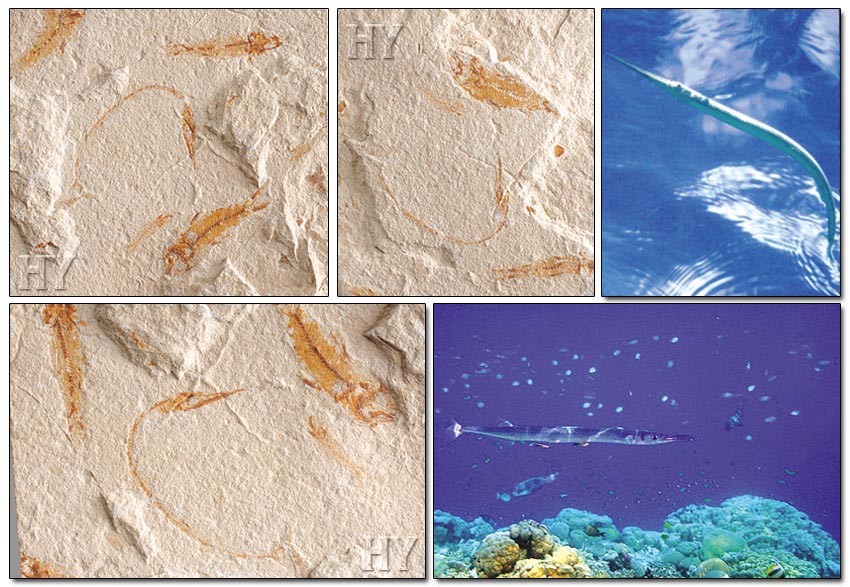 |
Age: 95 million years
Period: Cretaceous
Location: Haqel, Lebanon
All the needlefish fossils discovered to date are completely developed, together with all their structures. There is no fossil evidence to suggest that needlefish are descended from any other species or that they gradually assumed their present-day form. This is one finding that invalidates Darwinist claims and reveals that Creation is a manifest truth.
Brittlestar
 |
Age: 95 million years
Period: Cretaceous
Location: Haqel, Lebanon
Evolutionists constantly refer to hypotheses and engage in various forms of conjecture regarding the origin of life. Yet they are unable to support that conjecture with any scientific findings. When those findings are comprehensively examined, they reveal that all branches of science refute the idea of evolution.
Brittlestar fossils are one of these findings that refute evolution. Brittlestars have remained unchanged despite the enormously long passage of time. The brittlestar fossil pictured here is 95 million years old, but is identical to present-day brittlestars.
Eel
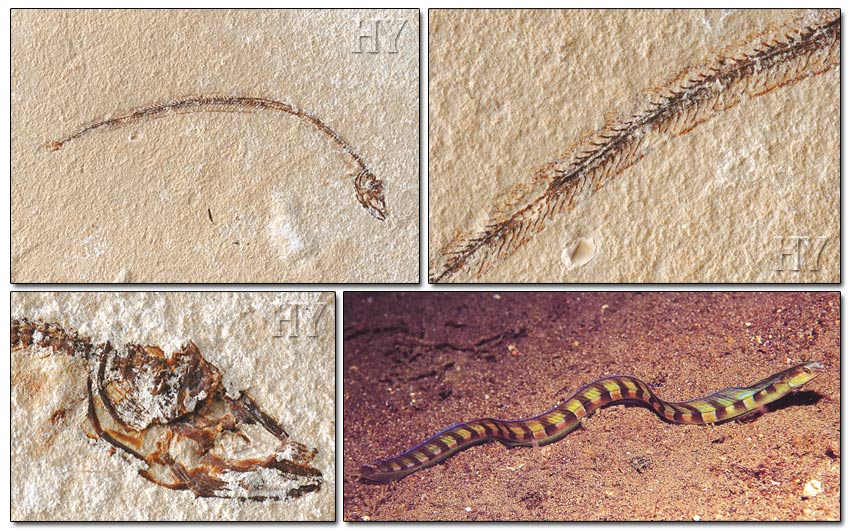 |
Age: 95 million years
Period: Cretaceous
Location: Haqel, Lebanon
Not a single example of a supposed forebear of any of the many different species in the fossil record has ever been encountered.
For instance, while countless fossils show that eels have always existed as eels, there are none that can be proposed as the ancestor of the eel. This fact represents a terrible predicament for evolutionists, and is openly stated by many scientists.
Professor Rudolf A. Raff, president of the Indiana Institute of Molecular Biology, and Thomas Kaufman from Indiana University say this on the subject:
"The lack of ancestral or intermediate forms between fossil species is not a bizarre peculiarity of early metazoan history. Gaps are general and prevalent throughout the fossil record." (R.A. Raff, and T.C. Kaufman, Embryos, Genes, and Evolution: The Developmental-Genetic Basis of Evolutionary Change, Indiana University Press, 1991, p. 34)
Sand Fish
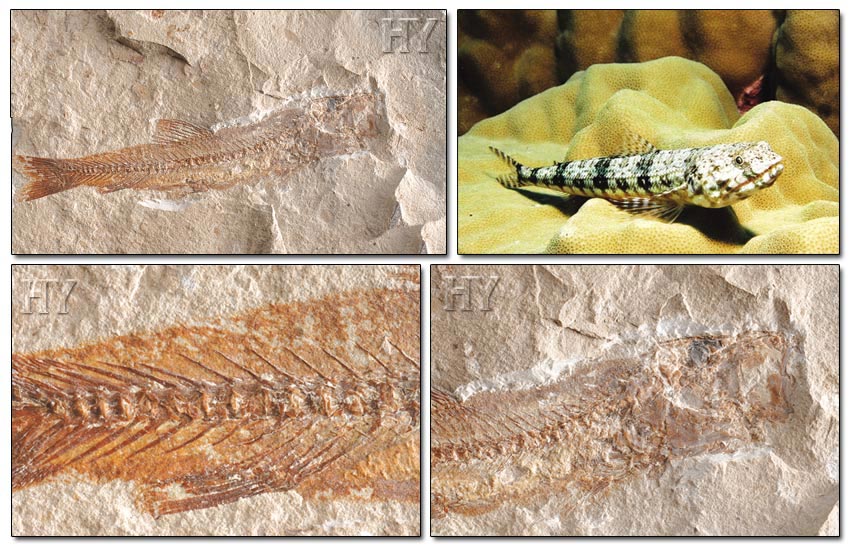 |
Age: 95 million years
Period: Cretaceous
Location: Haqel, Lebanon
No fossil of a strange-looking sandfish with partial fins and gills, only a partly formed respiratory system and developing eyes has ever been encountered. Every sandfish fossil discovered possesses exactly the same appearance and structure as present-day sandfish. This invalidates Darwinism, which maintains that living things developed gradually through very small changes, evolving from the primitive to the more advanced.
Crab
 |
Age: 50 million years
Period: Eocene
Location: Monte Baldo, Italy
Excavations over the last 150 years have revealed findings that have dealt a serious blow to evolution every single time. One of these is this fossil 50-million-year-old crab, showing that crabs have always existed as crabs.
The fact that not a single fossil specimen capable of supporting the myth of evolution has ever been found is doubtless one of evolutionists' worst nightmares. Moreover, this nightmare of theirs will never end. Because, as is they have been to date, all the fossils obtained in future will also show that evolution never happened and that God has created all living things.
In an article in Nature magazine, Edmund Leach, author of the book Rethinking Anthropology, stresses this:
"Missing links in the sequence of fossil evidence were a worry to Darwin. He felt sure they would eventually turn up, but they are still missing and seem likely to remain so." (E. R. Leach, "Men, bishops and apes," Nature, Vol. 293, September 3, 1981, p. 20)
Shrimp
 |
Age: 150 million years
Period: Jurassic
Location: Solnhofen Formation, Germany
One of those issues that make the supposed evolution of crustaceans impossible is the eye structure in the lobster and shrimp. A great many life forms belonging to the class Crustacea have refractive-type lens structures. Only two—the lobster and the shrimp—have a reflective mirrored eye. According to the unscientific evolutionist hypothesis, all living things belonging to the Crustacea must have evolved from a common forebear. If this claim were true, then it needs to be proved that the reflective mirrored eye structure also evolved from the refractive type lens structure.
Yet such a transition is impossible, because both types function perfectly with their own entirely different systems, and there is no point in looking for any "intermediate" form.
For a crustacean to gradually lose the lens in its eyes and for mirrored surfaces to emerge where formerly there had been lenses would leave the invertebrate deprived of sight in the meantime, and it could never survive.
In addition, no example of a semi-reflective and semi-refractive eye has ever been encountered in any fossil of any other life form. Every fossil discovered to date had perfect eyes, systems and structures, just like the 150-million-year-old shrimp pictured here.
Sand Fish
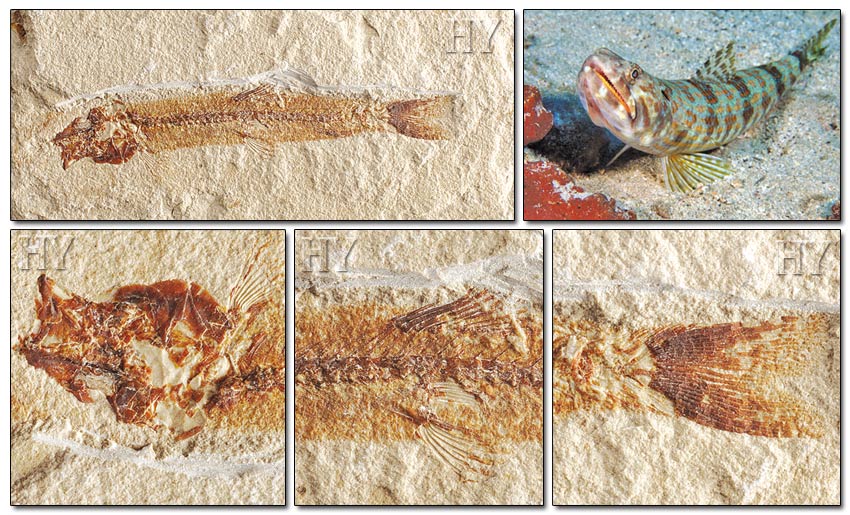 |
Age: 95 million years
Period: Cretaceous
Location: Haqel, Lebanon
Darwinists' worst predicament is their inability to find a single piece of evidence for a transition from invertebrates to fish, or from fish to reptiles, from reptiles to mammals and birds. The late evolutionist paleontologist Stephen Jay Gould describes the lack of evidence for these imaginary transitions as a disquieting problem:
"The absence of fossil evidence for intermediary stages between major transitions in organic design, indeed our inability, even in our imagination, to construct functional intermediates in many cases, has been a persistent and nagging problem for gradualistic accounts of evolution." (Stephen Jay Gould, "Is a New and General Theory of Evolution Emerging?", Paleobiology 6, 1980, pp. 119-130, reprinted in the collection Evolution Now: A Century After Darwin, ed. Maynard Smith, Freeman, 1982, p. 140)
Starfish
 |
Age: 430 million years
Period: Silurian
Location: Humevale Formation, Cloninbane, Victoria, Australia
Paleontologists have failed to come up with any supposed forebears of starfish. Neither have starfish been seen to change into other life forms. Were Darwinists' claims valid, starfish—which have survived for hundreds of millions of years—should long since have developed into other marine creatures, or even terrestrial life forms.
Yet no such transition ever happened. These creatures, which have existed as starfish for the last 430 million years, have demolished all claims to the effect that evolution represents the origin of life.
Sandperch (Pinguipedidae)
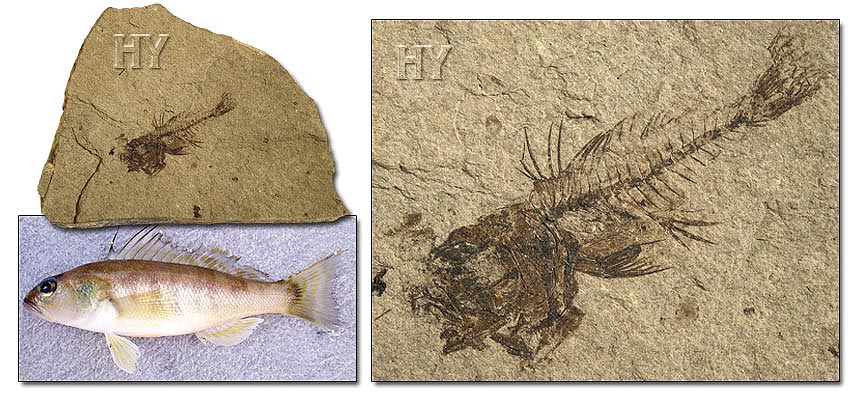 |
Age: 37 to 23 million years
Period: Cretaceous
Location: Poland
It has now been realized that most of the fossils evolutionists have pointed to as supposed evidence of evolution are hoaxes, or else evolutionists have advanced biased interpretations incompatible with scientific methodology. For example, the discovery of the fully-fledged bird Longisquama that lived 70 million years earlier than the fossil bird Archaeopteryx, depicted as "the leading intermediate form" for 100 years, made it clear that the latter was neither a "primitive bird" nor an "intermediate form," as had been claimed. In short, evolutionists have not one single fossil specimen they can hold up as evidence for evolution.
As can be seen from the 37-to-23-million-year-old fossil sandperch pictured here, the fossil record exhibits evident proofs of Creation.
Razorfish (Centriscus)
 |
Age: 23 to 5 million years
Period: Miocene
Location: Green River Formation, Colorado, USA
Fossils prove that fish have always existed as fish and never descended gradually from any other life form. No odd-looking fossil with semi-developed gills, an as-yet unformed digestive system, or with rudimentary fins has ever been seen. Every fish fossil discovered shows that that fish was in full and complete possession of all the features of the family to which it belongs. For example, the 23-5-million-year-old razorfish fossil pictured here reveals that these species have remained the same, and have never altered, for millions of years.
Faced by this evidence, Darwinists must stop blindly advocating the dogma of the myth of evolution and accept the truth indicated by science, which has proved that no evolutionary process ever took place, and has revealed that God has created living things.
Sea Cucumber (with its pair)
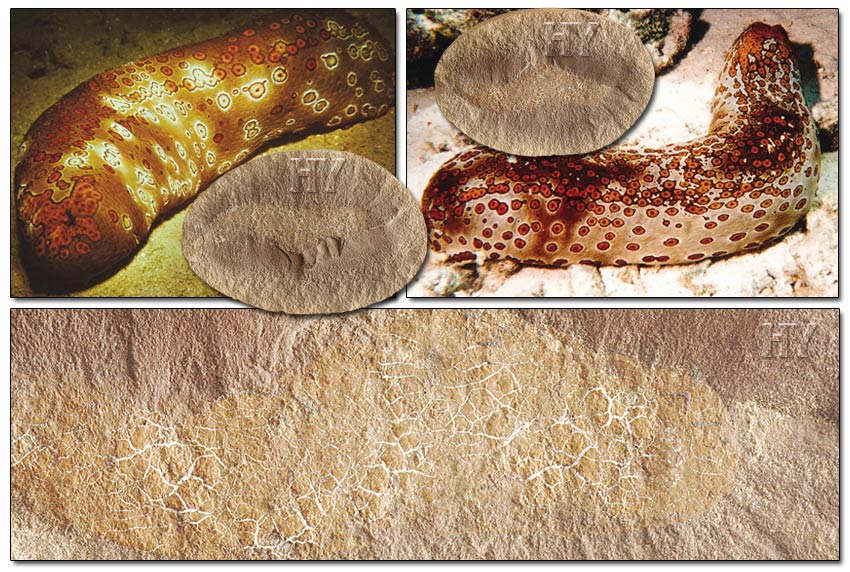 |
Age: 300 million years
Period: Carboniferous
Location: Francis Creek Shale, Braidwood, Illinois, USA
Sea cucumbers generally live on the sea bottom in areas close to the shore, and are grouped under the class Holothuroidea. The earliest known fossil specimens date back to the Devonian Period (417 to 354 million years ago). A comparison of sea cucumbers that lived 400 or 300 million years ago, and those living today shows that there is no difference between them.
This lack of change demolishes the claim that living things evolved by developing gradually over very long periods of time. Contrary to what Darwinists maintain, living things did not come into existence as the result of any evolutionary process. Our Lord, God, Lord of the worlds, created all things, both living and inanimate.
Starfish
 |
Age: 450 million years
Period: Ordovician
Location: Bromide Formation, Criner Hills, Carter County, Oklahoma, USA
The fossil record has revealed no life form that could possible be the supposed ancestor of starfish. Neither has it shown that starfish developed into any other life form over the course of time.
This same dynamic applies to all living things. Darwinists have no fossil evidence through which they can maintain that life forms are descended from one another. The late evolutionist Stephen Jay Gould admitted how the accounts of the supposed evolution of marine invertebrates are nothing more than myths and are based upon no scientific evidence in the following terms:
". . . one feature stands out as most puzzling—the lack of clear order and progress through time among marine invertebrate faunas. We can tell tales of improvement for some groups, but in honest moments we must admit that the history of complex life is more a story of multifarious variation about a set of basic designs than a saga of accumulating excellence." (Stephen Jay Gould, "The Ediacaran Experiment," Natural History 2/84, p. 22)
Coral
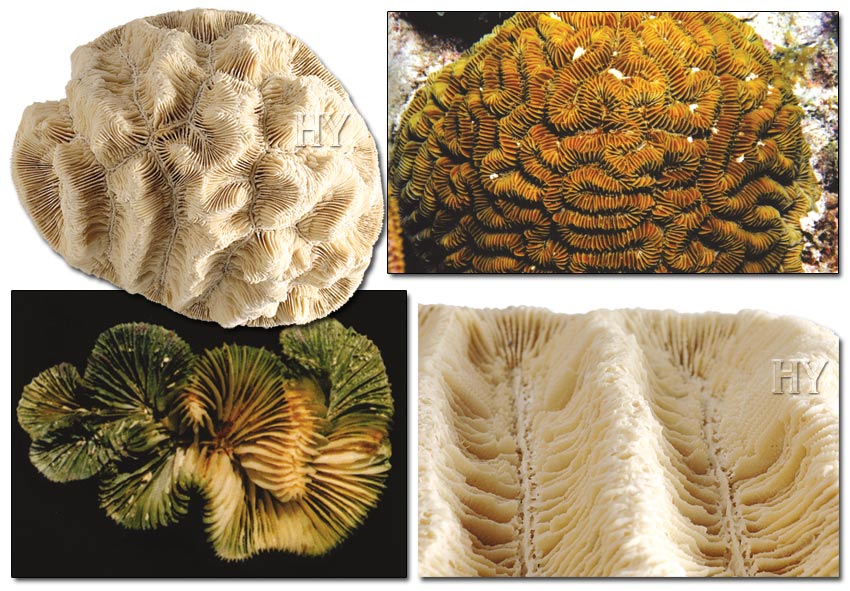 |
Age: 3 million years
Period: Pliocene
Location: Caloosahatchee Formation, Manatee County, Florida, USA
Corals (Antozoons) are invertebrate organisms that are known to have lived since the Cambrian Period (543 to 490 million years ago), and of which there are many fossil specimens dating back to the Ordovician period (490 to 443 million years ago).
Corals come in various types; soft, horny, spiny and true corals. Coral beds form as a result of coral skeletons accumulating in a specific location over thousands of years. Corals live either alone or in colonies. They tend to live in warm seas, attached to large rocks on the sea bed, though free-moving, newly-hatched ones are rarely encountered.
Corals deal a severe blow to Darwinism, given their sophisticated structures that have remained unchanged for hundreds of millions of years. Like all other living things, they are the work of our Lord's sublime creation.
Troutperch (Percopsidae)
 |
Age: 54 to 37 million years
Period: Eocene
Location: Green River Formation, Kemmerer, Wyoming, USA
These fish, which belong to the class Percopsiformes, generally live in fresh water in North America. Some evolutionists claim that fish belonging to this class possess primitive features. However, investigations have revealed that the vertebrates in question actually have very complex structures. Some families even amaze evolutionists through the extraordinary features they display in nest-building and caring for their offspring.
The fossil pictured here is around 50 million years old and shows that fish of this species have survived exactly the same over the last 50 million years.
Scallop
 |
Age: 300 million years old
Period: Carboniferous
Location: Francis Creek Shale, Braidwood, Illinois, USA
There are an estimated 15,000 extinct species of oysters, traces of which can still be seen in the fossil record, and some 11,000 species still alive today. The fossil pictured here, a member of the family Pectinidae, shows that the mollusks in question have remained unaltered for hundreds of millions of years.
Evolutionists are unable to account for this. In such cases, they prefer resorting to demagoguery, pretending not to understand the issue, and confusing the public with imaginary tales. The fact is, however, that if they were to honestly evaluate the information revealed by the scientific facts, they would see that the theory of evolution has collapsed under the weight of evidence in the fossil record.
Flying Fish
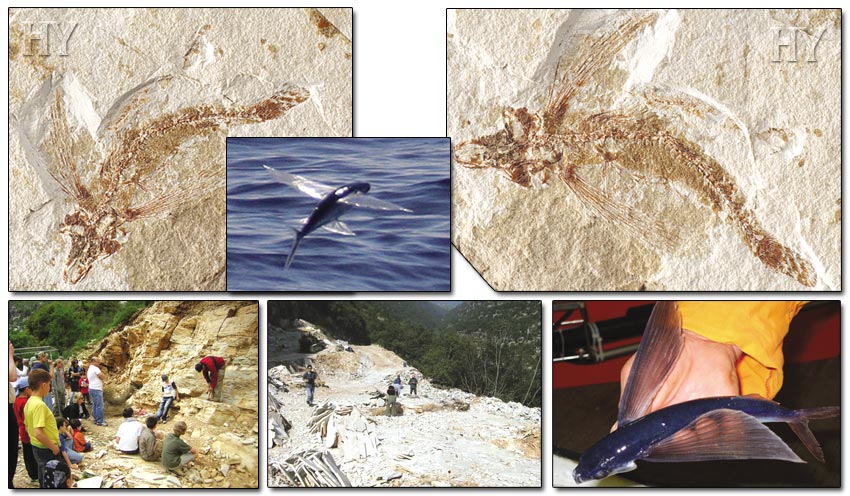 |
| Darwin hoped that excavations undertaken after his day would produce fossils representing proof of his theory of evolution. Yet even though digs were conducted for decades all over the world, no such evidence was forthcoming. All the fossils unearthed to date have proved that living things had not undergone evolution. The photos to the left show fossil research being undertaken in Haqel and Nammoura in Lebanon, well-known for their rich fossil beds. |
Age: 95 million years
Period: Cretaceous
Location: Haqel, Lebanon
Darwinist logic makes exceedingly ridiculous and unscientific claims. For example, were life to be in a constant state of change and transition, as evolutionists maintain, then flying fish should long since have grown full-developed wings and turned into strange, flying gilled creatures. Yet contrary to evolutionist claims, these fish have survived for tens of millions of years without undergoing any changes whatsoever.
The fact that flying fish that existed 95 million years ago are identical to those alive today demolishes all evolutionist logic.
Coral
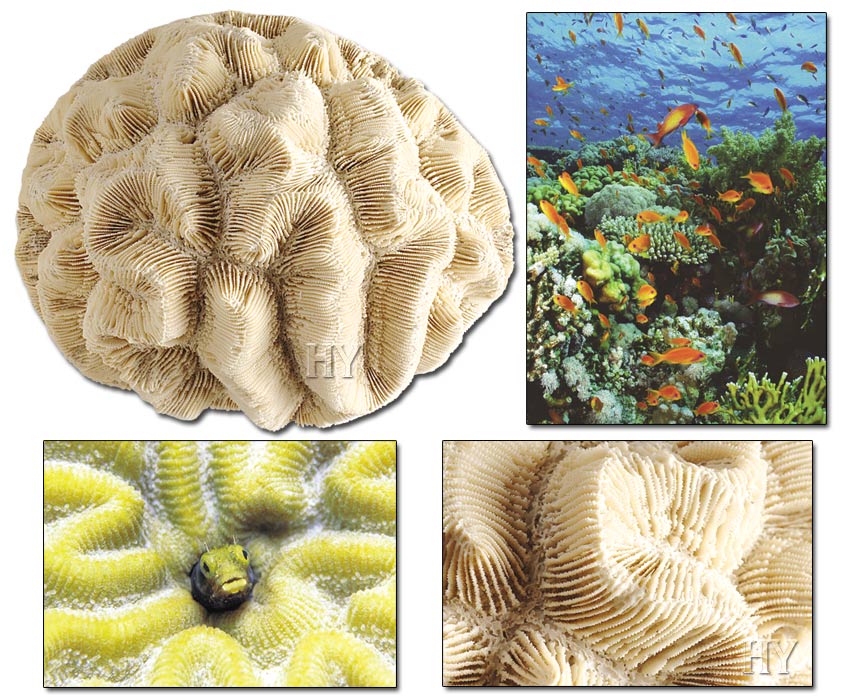 |
| Over time, coral skeletons accumulate and build themselves toward the surface of the ocean, in structures known as coral beds or coral reefs. |
Age: 3 million years
Period: Pliocene
Location:Caloosahatchee Formation, Manatee County, Florida, USA
The coral pictured here is some 3 million years old. Corals that lived 300 million years ago, those that existed only 3 million years in the past and those still living today are all identical, in terms of both appearance and structure. While this uniformity invalidates the claim of evolution, it also once again demonstrates that Creation is an irrefutable fact.
- Introduction
- Evolutionists' Intermediate-Form Dilemma
- Cambrian Fossils and The Creation of Species
- "Missing Link Discovered" Headlines are an Unscientific Deception
- Darwin's Illogical And Unscientific Formula
- Fossil Specimens of Land Animals (1/2)
- Fossil Specimens of Land Animals (2/2)
- Fossil Specimens of Marine Creatures (1/5)
- Fossil Specimens of Marine Creatures (2/5)
- Fossil Specimens of Marine Creatures (3/5)
- Fossil Specimens of Marine Creatures (4/5)
- Fossil Specimens of Marine Creatures (5/5)
- Fosil Specimens of Plants (1/2)
- Fosil Specimens of Plants (2/2)
- Fossil Specimens of Insects (1/2)
- Fossil Specimens of Insects (2/2)
